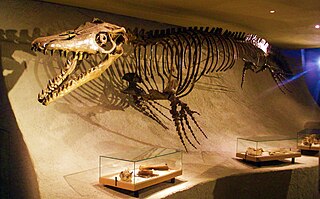
Mosasaurus is the type genus of the mosasaurs, an extinct group of aquatic squamate reptiles. It lived from about 82 to 66 million years ago during the Campanian and Maastrichtian stages of the Late Cretaceous. The genus was one of the first Mesozoic marine reptiles known to science—the first fossils of Mosasaurus were found as skulls in a chalk quarry near the Dutch city of Maastricht in the late 18th century, and were initially thought to be crocodiles or whales. One skull discovered around 1780 was famously nicknamed the "great animal of Maastricht". In 1808, naturalist Georges Cuvier concluded that it belonged to a giant marine lizard with similarities to monitor lizards but otherwise unlike any known living animal. This concept was revolutionary at the time and helped support the then-developing ideas of extinction. Cuvier did not designate a scientific name for the animal; this was done by William Daniel Conybeare in 1822 when he named it Mosasaurus in reference to its origin in fossil deposits near the Meuse River. The exact affinities of Mosasaurus as a squamate remain controversial, and scientists continue to debate whether its closest living relatives are monitor lizards or snakes.

The Mosasaurinae are a subfamily of mosasaurs, a diverse group of Late Cretaceous marine squamates. Members of the subfamily are informally and collectively known as "mosasaurines" and their fossils have been recovered from every continent except for South America.
Plioplatecarpinae is a subfamily of mosasaurs, a diverse group of Late Cretaceous marine squamates. Members of the subfamily are informally and collectively known as "plioplatecarpines" and have been recovered from all continents, though the occurrences in Australia remain questionable. The subfamily includes the genera Latoplatecarpus, Platecarpus, Plioplatecarpus and Plesioplatecarpus.

The Halisaurinae are a subfamily of mosasaurs, a group of Late Cretaceous marine lizards. They were small to medium-sized, ranging from just under 3 meters in Eonatator sternbergi to as much as 8 or 9 meters in Pluridens serpentis. They tended to have relatively slender jaws and small, numerous teeth, suggesting a diet of small fish and other prey. Although the skeleton is primitive compared to other Mosasauridae in many respects, halisaurines had the distinctive hypocercal tail of other mosasaurids suggesting good swimming ability, and they persisted alongside other mosasaurs until the end of the Cretaceous. The earliest known remains of halisaurines occur in rocks of Santonian age and the subfamily persists until the latest Maastrichtian. Halisaurines are known from North and South America, Europe, Asia and Africa, indicating a more or less global distribution in the Late Cretaceous. Four genera are currently recognized: Eonatator, Halisaurus, Phosphorosaurus and Pluridens.
Eonatator is an extinct genus of marine lizard belonging to the mosasaur family. It is a close relative of Halisaurus, and part of the same subfamily, the Halisaurinae. It is known from the Late Cretaceous of North America, Colombia and Sweden. Originally, this taxon was included within Halisaurus, but was placed in its own genus, which also led to the subfamily Halisaurinae being created for the two genera.
Platecarpus is an extinct genus of aquatic lizards belonging to the mosasaur family, living around 84–81 million years ago during the middle Santonian to early Campanian, of the Late Cretaceous period. Fossils have been found in the United States and possible specimens in Belgium and Africa. A well-preserved specimen of Platecarpus shows that it fed on moderate-sized fish, and it has been hypothesized to have fed on squid, and ammonites as well. Like other mosasaurs, it was initially thought to have swum in an eel-like fashion, although another study suggests that it swam more like modern sharks. An exceptionally well-preserved specimen of P. tympaniticus known as LACM 128319 shows skin impressions, pigments around the nostrils, bronchial tubes, and the presence of a high-profile tail fluke, showing that it and other mosasaurs did not necessarily have an eel-like swimming method, but were more powerful, fast swimmers. It is held in the Natural History Museum of Los Angeles County. Isotopic analysis on teeth specimens has suggested that this genus and Clidastes may have entered freshwater occasionally, just like modern sea snakes.
Plotosaurus is an extinct genus of mosasaurs who lived during the Upper Cretaceous (Maastrichtian) in what is now North America. Only one species is recognized, P. bennisoni, described by Berkeley paleontologist Charles Lewis Camp in 1942 from fossils discovered in California. Originally named Kolposaurus, it was changed to Plotosaurus in 1951 when Camp discovered that the name had already been assigned to a type of nothosaur. Unlike other mosasaurids, Plotosaurus possesses a morphology converging with those of ichthyosaurs, suggesting a much more advanced swimming adaptation than some of its close relatives.

Globidens is an extinct genus of mosasaurid oceanic lizard classified as part of the Globidensini tribe in the Mosasaurinae subfamily.
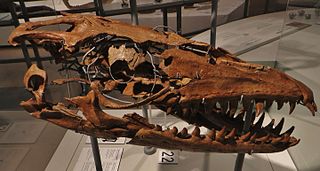
Prognathodon is an extinct genus of marine lizard belonging to the mosasaur family. It is classified as part of the Mosasaurinae subfamily, alongside genera like Mosasaurus and Clidastes. Prognathodon has been recovered from deposits ranging in age from the Campanian to the Maastrichtian in the Middle East, Europe, New Zealand, and North America.
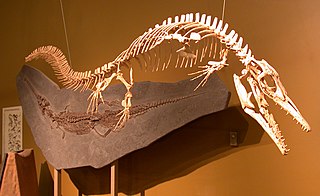
Halisaurus is an extinct genus of marine reptile belonging to the mosasaur family. The holotype, consisting of an angular and a basicranium fragment discovered near Hornerstown, New Jersey, already revealed a relatively unique combination of features and prompted a new genus to be described. It was named by Othniel Charles Marsh in 1869 and means "ocean lizard". It was renamed by Marsh to Baptosaurus in 1870, since he believed the name to already be preoccupied by the fish Halosaurus. According to modern rules, a difference of a letter is enough and the substitute name is unneeded, making "Baptosaurus" a junior synonym.

Pluridens is an extinct genus of marine lizard belonging to the Mosasauridae. Pluridens is placed in the subfamily Halisaurinae with the genera Phosphorosaurus, Eonatator and Halisaurus. Compared to related halisaurines, Pluridens had longer jaws with more teeth, and smaller eyes. It also grew large size, measuring 5–6 m (16–20 ft) long and perhaps over 9 m (30 ft) in some individuals. The jaws in some specimens are robust, and sometimes show injuries suggestive of combat. The jaws may have been used for fighting over mates or territories.
Goronyosaurus is an extinct genus of marine lizard belonging to the mosasaur family. Fossils of Goronyosaurus are exclusively known from the Late Maastrichtian of the Iullemmeden Basin in West Africa, specifically the Dukamaje Formation of Niger and Nigeria and Farin Doutchi Formation of Niger. The type specimen was first described in 1930 as Mosasaurus nigeriensis, but subsequent remains revealed a highly unique set of adaptations that prompted the species to be reclassified as the only species of the new genus Goronyosaurus in 1972. These unique adaptations have made Goronyosaurus notoriously difficult to classify within the Mosasauridae and it is often left out of phylogenetic analyses, although most authors agree that Goronyosaurus belonged to Mosasauridae.

Aphrosaurus was an extinct genus of plesiosaur from the Maastrichtian. The type species is Aphrosaurus furlongi, named by Welles in 1943. The holotype specimen was discovered in the Moreno Formation in Fresno County, California in 1939 by rancher Frank C. Piava. A second specimen - LACM 2832 - was also found in the same formation and initially diagnosed as a juvenile of the same species, but has since been removed from the genus.
Moanasaurus was a genus of mosasaur from the Late Cretaceous period. Its fossil remains have been discovered in the North Island of New Zealand. Moanasaurus was a very large mosasaurine known originally from a disarticulated skull, vertebrae, ribs and flipper bones. The skull measures 78 cm (31 in) in length, which shows that Moanasaurus was one of the largest in the subfamily of Mosasaurinae. Researchers argue that some Antarctic Mosasaurus remains may be attributed to this genus.
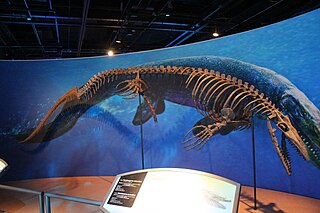
Taniwhasaurus is an extinct genus of mosasaurs that lived during the Campanian stage of the Late Cretaceous. It is a member of the subfamily Tylosaurinae, a lineage of mosasaurs characterized by a long toothless conical rostrum. Two valid species are attached to the genus, T. oweni and T. antarcticus, known respectively from the fossil record of present-day New Zealand and Antarctica. Two other species have been nominally classified within the genus, T. 'capensis' and T. 'mikasaensis', recorded in present-day South Africa and Japan, but their attribution remains problematic due to the fragmentary state of their fossils. The generic name literally means "taniwha lizard", referring to a supernatural aquatic creature from Māori mythology.

Plesiotylosaurus, meaning "near Tylosaurus", is an extinct genus of marine lizard belonging to the mosasaur family. It is classified as part of the Mosasaurinae subfamily, alongside genera like Mosasaurus and Prognathodon. The genus contains one species, Plesiotylosaurus crassidens, recovered from deposits of Middle Maastrichtian age in the Moreno Formation in California.

Angolasaurus is an extinct genus of mosasaur. Definite remains from this genus have been recovered from the Turonian and Coniacian of Angola, and possibly the Coniacian of the United States, the Turonian of Brazil, and the Maastrichtian of Niger. While at one point considered a species of Platecarpus, recent phylogenetic analyses have placed it between the (then) plioplatecarpines Ectenosaurus and Selmasaurus, maintaining a basal position within the plioplatecarpinae.
Eremiasaurus is a genus of mosasaurs, an extinct group of marine reptiles. It lived during the Maastrichtian stage of the Late Cretaceous in what is now North Africa. Only one species is known, E. heterodontus, described in 2012 from two remarkably complete fossil specimens discovered in the Ouled Abdoun Basin, Morocco. This site is known to have delivered a significant number of other related mosasaurs.
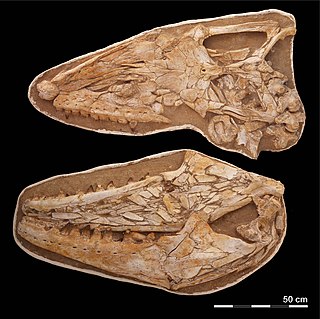
Thalassotitan is an extinct genus of large mosasaurs that lived during the late Maastrichtian of the Cretaceous period in what is now Morocco, around 66 million years ago. The only known species is T. atrox, described in 2022 from fossils discovered in the Ouled Abdoun Basin, where many other mosasaurs have been found. It was assigned to the tribe Prognathodontini alongside other mosasaurs like Prognathodon and Gnathomortis. The prognathodontines are separated from other mosasaurs based on their massive jaws and robust teeth.
Jormungandr is an extinct genus of mosasaurid squamates from the early Campanian Pierre Shale of North Dakota, United States. The genus contains a single species, J. walhallaensis, known from a nearly-complete skull and partial skeleton. Jormungandr was a medium-sized mosasaur, at around 6–8 metres (20–26 ft) long, and its skeletal anatomy exhibits a mix of features seen in both basal and derived mosasaurines.














